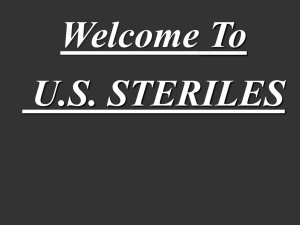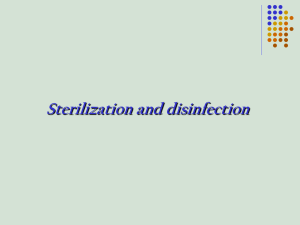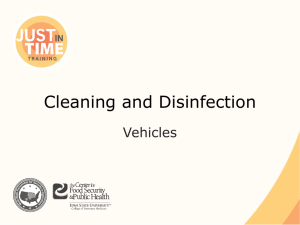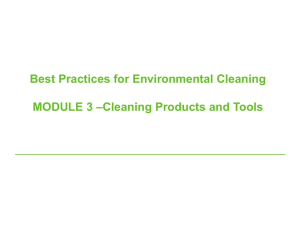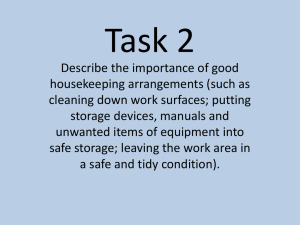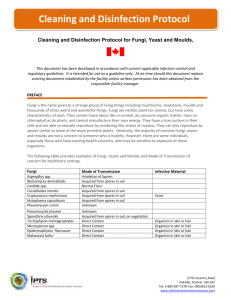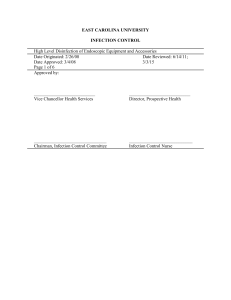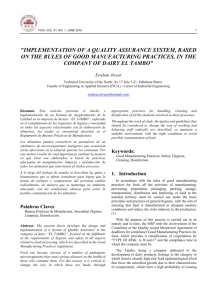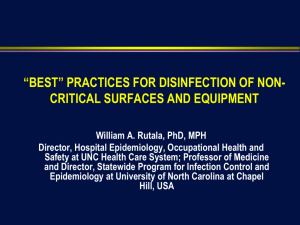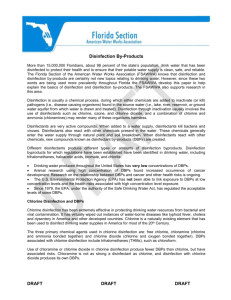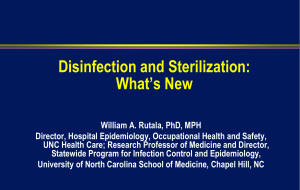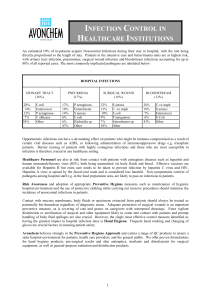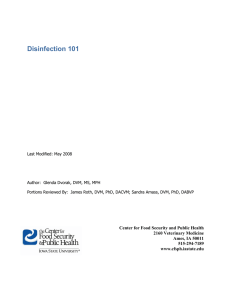Cleaning and disinfection a summary
advertisement
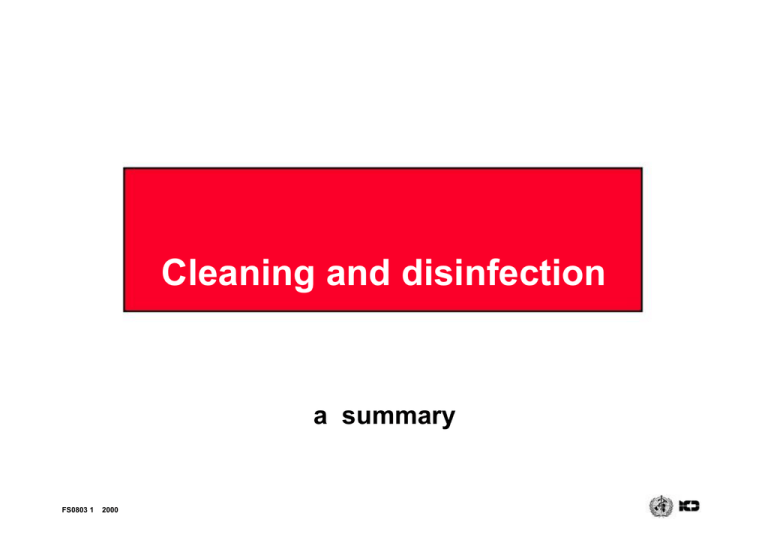
Cleaning and disinfection a summary FS0803 1 2000 Contents General principles cleaning disinfection safe use of chemicals application in the home application in catering and the food industry FS0803 2 2000 General principles The purpose of cleaning is to remove food residues and dirt The purpose of disinfection is to reduce the numbers of living microorganisms Disinfection does not usually kill bacterial spores To be effective, disinfection must be preceded by thorough cleaning FS0803 3 2000 Steps in cleaning / disinfection storing exposed foods to avoid chemical contamination removing gross debris rinse cleaning, usually with a detergent rinse disinfection rinsing with clean water drying FS0803 4 2000 Biofilms Some microorganisms produce polysaccharides Polysaccharides combine with hard water salts to create biofilms on surfaces Biofilms are tenacious and difficult to remove This problem is important for the food manufacturing industry FS0803 5 2000 Biofilms FS0803 6 2000 Detergents polar head (hydrophilic) non-polar tail (hydrophobic) FS0803 7 2000 Detergents for use with foods Alkaline (anionic) detergents are used for organic materials (soils): fats / oils proteins carbohydrates Acidic (cationic) detergents are used for inorganic materials (soils): scale from hard water (calcium, magnesium, salts) other mineral films (iron, sulphates) mineral-rich food debris (milkstone) FS0803 8 2000 Choice of detergent Soil solubility ease of removal change on heating best detergent protein water insoluble difficult denatures, more tenacious chlorinated alkaline fats / oils water insoluble difficult polymerisation more difficult to clean alkaline carbohydrates water soluble easy mineral salts variable water insolubility variable caramelisation, alkaline more difficult to clean generally easy acid FS0803 9 2000 Factors affecting cleaning Time Temperature Detergent concentration Mechanical action FS0803 10 2000 Importance of cleaning before disinfection Food residues protect microorganisms provide nutrients for microbes reduce effectiveness of disinfectants reduce equipment efficiency (e.g. heat exchangers) FS0803 11 2000 Methods of disinfection High Temperature hot water steam Chemical halogen or oxidising (e.g. chlorine, iodine) surfactant or non-oxidising FS0803 12 2000 Hot water kills all vegetative microorganisms (and some spores) no chemical residues not corrosive gets to hard-to-reach areas FS0803 13 2000 Principles of chemical disinfection Surfaces must be clean A disinfectant should be non-toxic to man have wide antimicrobial activity (pathogens and spoilage organisms) kill rather than inhibit microorganisms not taint the food or drink FS0803 14 2000 Oxidising disinfectants Chlorine compounds inorganic (bleach, sodium hypochlorite) salts of organic carrier (formulated to control corrosion) chlorine dioxide Iodine compounds iodophors Ozone Peracetic acid FS0803 15 2000 Non-oxidising disinfectants Quarternary ammonium compounds FS0803 16 2000 Factors affecting efficacy Contact time Temperature Concentration pH Nature of “soil” Compatibility with detergents FS0803 17 2000 Rinsing and drying after cleaning / disinfection Equipment and surfaces should be rinsed with potable water Air-drying is essential because microbial growth may occur in the water film FS0803 18 2000 Disinfectant selection Hot water + + + + + + + + Active chlorine ++ ++ ++ ++ ++ + ++ + Iodophors + + ++ ++ ++ + ++ ++ Hydrogen peroxide + + + ++ ++ + + + Peracetic acid ++ ++ ++ ++ ++ ++ ++ + Quarternary ammonium compounds - - ++ ++ + - ++ + Aldehydes + + + + + + + + FS0803 19 2000 Cleaning protocols for the food and catering industries Cleaning protocols are needed for surfaces in contact with food utensils used with food cleaning equipment (mops, brushes, buckets) all other areas in the kitchen and canteen FS0803 20 2000 Safe use of chemicals Always follow the supplier’s instructions Never mix chemicals unless the supplier states that it is safe Acids and alkalis must never be mixed (exothermic reaction) Hypochlorite must never be mixed with acids (chlorine gas released) nitrogenous materials (may form explosive compounds) FS0803 21 2000 Pest control Pathogens can be spread by flies Cockroaches rats mice procedures must be in place to keep them out of the food processing and handling areas FS0803 22 2000 Key messages for the home Surfaces / utensils must be clean to achieve satisfactory disinfection Cleaning is improved with a simple detergent Disinfection is achieved with hot water or with hypochlorite solution Cleaned surfaces and utensils must be kept dry Chemicals must be stored safely FS0803 23 2000 Key messages for the catering and food industries Clean surfaces are necessary to ensure satisfactory disinfection Facilities/equipment must be adequate to do the job Efficacy of disinfectants depends on chemical composition, time and temperature Each disinfectant has unique properties Protocols must be followed for all cleaning/ disinfection activities Chemicals must be used and stored safely Cleaning should be monitored FS0803 24 2000


